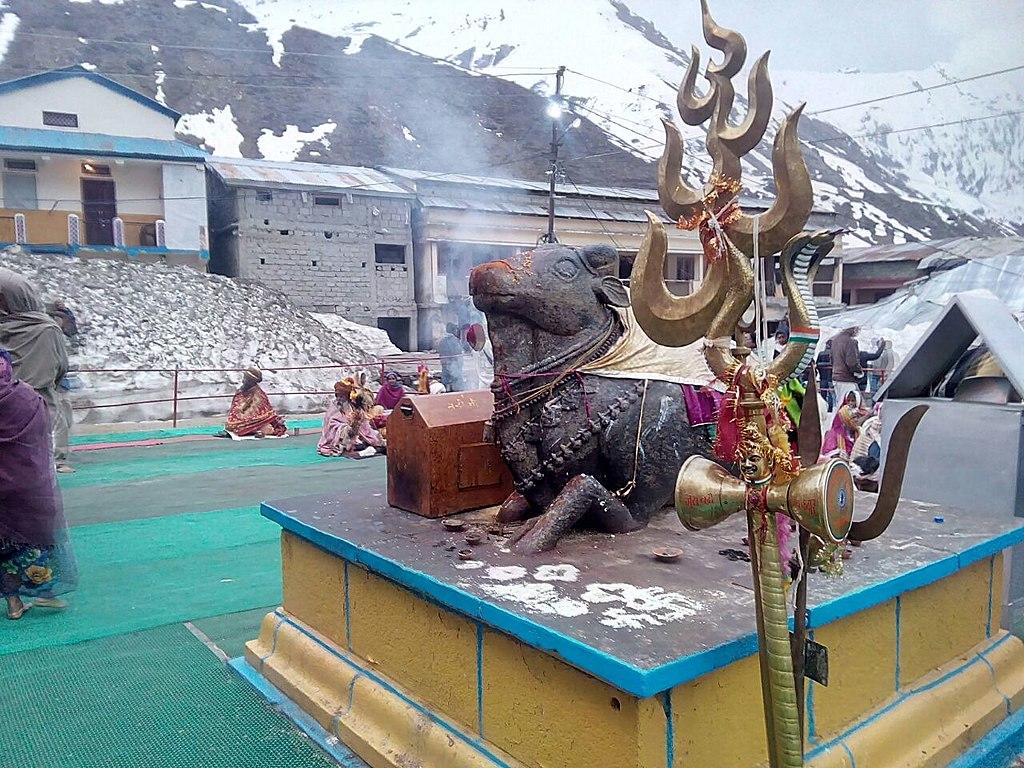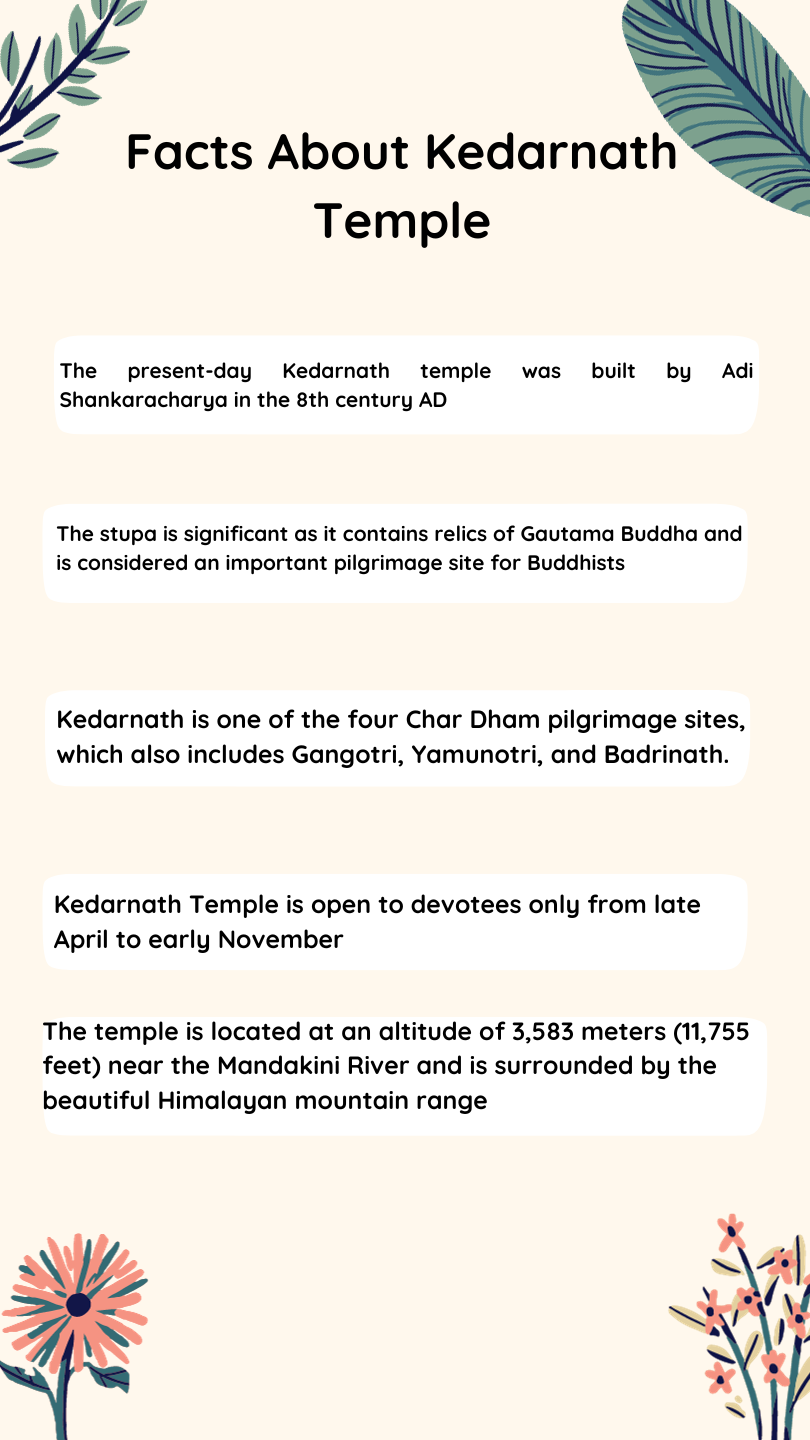In the region of Uttarakhand, the “Land of Gods,” there are hundreds of ancient holy sites dedicated to Lord Shiva and many more holy sites in general.
Upon visiting the area, it’s easy to see why ancient peoples found holiness in this mountainous region; the Himalayas create a unique, enrapturing atmosphere while the air tastes pure and fresh. Clean water springs are abundant and there is a sense of calmness.
Especially in the modern age of vehicles, air pollution, and too much noise, these serene mountains are truly a getaway for people to connect with their religion or spirituality.
So why was Kedarnath Temple specifically created here and what can you still experience of it today?

Where is Kedarnath Temple?
As mentioned, Kedarnath Temple is located in a remote location in the Himalayan mountains in Uttarakhand, India.
The temple was built by people who were travelling by foot or horseback across the land, so naturally, the location of the temple is inaccessible by vehicles.
Methods of Transportation
The only ways to get all the way to the temple are by walking, riding on ponies, or taking a palanquin (doli).
To get to Kedarnath town and Temple, you must first get to the closest town, Gaurikund.
The closest major city to Gaurikund is Haridwar, which is well-connected to the rest of India via road. You can also come to the Rishikesh Railway Station and take a bus or taxi to Gaurikund. By air, you can fly to Jolly Grant Airport in Dehradun and take a bus or taxi to Gaurikund.
Once you reach Gaurikund, you must walk, travel on horseback, or utilise a palanquin to get to Kedarnath town and then the Temple, which is about 14 km away.
Alternatively, you can take a helicopter ride to the Kedarnath Helipad, which is only about 1 km away from the temple. You will need to walk or take a pony to and from the temple and the helipad.
When is the Temple Open?
The temple is only open from about May (depending on when the snow melts) to November.
Winters in the Himalayas are far too extreme and dangerous for people to stay or travel in the higher parts of the mountains. The snowfall is too heavy and the risk of avalanche is too great.
Kedarnath is at an elevation of 3,583 m (11,755 ft), making it susceptible to extreme winter weather.
In the winter, the vigraha (deity) of the temple is carried down to Ukhimath (elevation 1,311 m (4,301 ft)) where it can be worshipped.

Kedarnath temple with the mountain view | Source: Wikimedia commons
The Legend of Kedarnath Temple
Nobody can tell for certain who built the temple and when. All that is for sure is that the stone that makes up the temple is quite old; it’s not certain just how old it is, but it’s likely to be at least 1,200 years old.
All that remains of the creation story of Kedarnath Temple is the tale of the Pandavas.
Atonement of the Pandavas
According to Hindu legend told in Mahabharata, the Pandavas and Kauravas fought against each other in the Kurukshetra War. Even though they were cousins, they fought so much that many people were slain.
The Pandavas, victorious in battle, felt ashamed at having slaughtered their kin, so they went in search of Lord Shiva for atonement.
The legend goes that Shiva did not want to interact with the Pandavas because he was so disgusted by their behaviour, so he avoided them by turning into a bull (or buffalo/bafellow) and hiding in the Garhwal region.
Still seeking Shiva’s blessings, the Pandavas followed him to the Himalayas.
One of the Pandavas, Bhima, spotted Lord Shiva in his bull form (Nandi) and attempted to catch him by the tail and hind legs.
One variation of the legend states that Bhima did catch Nandi, which caused Shiva’s form to be ripped asunder. The other variation says that Nandi dove into the ground and separated into pieces of his own accord.
Either way, it’s believed that Shiva was pleased with the penance of the Pandavas at this point, and pieces of Nandi reappeared in various places in the nearby land. The place where he dove into the ground and left behind his buffalo hump is the exact location of Kedarnath Temple today.
"...the sound "Shiva" emanates from this place."
Sadhguru
Other Constructions of the Temple
Whether there is any merit to the ancient tale is up for debate. However, it’s believed that the current temple was built by Adi Shankara in the 8th century.
The current structure was further repaired in the 19th century.
Avalanches and earthquakes have damaged the temple several times throughout history, requiring repair or rebuilding.

Kedarnath Nandi | Source: Deepak Seth on Wikimedia commons

What Makes Kedarnath Temple So Special?
Why has Kedarnath Temple remained so historically significant, and why do pilgrims and sight-seers still go there so often each year?
There are a lot of different superlatives given to this temple, which is why it has become known as one of the most auspicious Shiva temples in India.
Elevation
First of all, the height of Kedarnath Temple makes it special among Shiva temples. It is one of the highest Shiva temples in all of India at a height of 3,583 m (11,755 ft). All of the temples of the Panch Kedar are at a very high elevation.
Part of the Panch Kedar
Speaking of the Panch Kedar, Kedarnath is the first of this series of five temples. The name refers to the five temples relating to Kedarnath.
These temples are the ones that are believed to have been created by Shiva’s buffalo form, Nandi, emerging from the ground.
- Kedarnath Temple: Where Nandi dove into the ground, leaving just his hump above the surface.
- Tungath Temple: Where Nandi’s arms emerged.
- Rudranath Temple: Where Nandi’s face emerged.
- Madmaheshwar Temple: Where Nandi’s belly emerged.
- Kalpeshwar Temple: Where Nandi’s head and hair emerged.
One of the Holiest 12 Jyotir Lingams
The 64 original Jyotirlingam mentioned in the Shiva Purana are the devotional representations of Lord Shiva. The word “jyotirlingam” means “sign of radiance.”
It is said that, in order to settle the argument between Lord Brahma and Lord Vishnu about who was more supreme, Lord Shiva turned into Jyotirlinga - a huge, infinite pillar of light. The areas where Shiva appeared as a fiery light are the original 64 Jyotirlingam.
The names of the most holy 12 temples of the 64 are also outlined in the Shiva Purana.
Kedarnath is believed to be the closest temple to Shiva’s abode in Mount Kailash.
Part of the Chota Char Dham Yatra
The Chota Char Dham is an important set of Temples that Hindus visit for pilgrimage (Yatra).
While the original Char Dham Yatra was made of 4 temples - Puri, Rameswaram, Dwarka, and Badrinath - representing only 2 gods (Vishnu and Shiva), the Chota Char Dham was created to include temples dedicated to the big 3 deities in Hinduism (Vishnu, Shiva, and Shakti).
The 4 temples which make up the Chota Char Dham Yatra are Kedarnath, Badrinath, Gangotri, and Yamunotri.
It is believed that once a person completes the Chota Char Dham Yatra, all their sins are washed away and they can process towards Moskha or enlightenment.

The Holy Paadal Petra Sthalam Temples
There are 276 temples known as Paadal Petra Sthalam or, Tevara Sthalam. They are outlined in the verses written by the 63 Shaiva Nayanars, who were Tamil Hindu saints in the 6th - 9th centuries.
“Tevaram” means “garland of divine songs,” and refers to the collection of sung verses in praise of Shiva. The three main Tamil poets who created this set of songs were Thirugnana Sambanthar, Tirunavukkarasar (aka Appar), and Sundaramoorthy Nayanar (aka Sundarar). Collectively, they're known as Shaiva Kuruvars.
“Paadal Petra Sthalam” means “temples that were sung in the verses.”
Naturally, the Kedarnath Temple is one of the 276 temples sung about in the verses.
For all these reasons, Kedarnath is considered one of the holiest temples in Hinduism.
Facts About Kedarnath Temple
Kedarnath Temple is full of interesting facts, since it has a long history, is tied to Hindu lore, and is still a relevant landmark today.
Architectural Marvels of Kedarnath
The temple itself is a pinnacle of architecture. The gray stone slabs used to make the temple are interlocked and held with iron clamps and no mortar.
Inside the Garbha Griha or the inner sanctum, a naturally occurring stone formation of a stambha, a pillar, measures about 12 ft (3.6 m) tall. It is worshipped as Lord Shiva in his Sadashiva form.
There is also a pillared hall filled with images and statues of many deities, including Parvati, Lord Krishna, Nandi, Virabhadra, Draupadi, as well as the five Pandava princes.
It is also said that there is a stone lingham inside that has an intricately carved head of a man, which matches a similar carving found in the nearby temple of Triyuginarayan where Shiva and Parvati were wed.
Anointing with Ghee
One of the ways people pay respects to Shiva at Kedarnath Temple is by rubbing ghee on the Lingham (The Kedarnath Shivling) during prayers.
This pyramid-like shaped rock is believed to be the hump of Shiva’s bull form and a Swayambhu, a Lingham that spontaneously appeared from the Earth.
Some believe that the Lingham started out no bigger than a thumb, but with prayer and application of ghee has grown to be about 4 ft (1.2 m) tall as we see it today.
Daily Rituals at Kedarnath
During the summer season, daily pujas are conducted by the main priests of the temple, instructed by the Rawal, the main priest.
Rituals conducted at the temple include Maha Abishek, Shyan Aarti, Darshan, and Abishek for the general public. During the earlier hours, the public may anoint the Lingham with ghee.
Here are the times according to Tour My India.
| Event | Time |
|---|---|
| Daily Puja (Maha Abhishek) at Kedarnath Temple Starts From | 4:00 AM |
| Daily Puja (Shyan Aarti) at Kedarnath Temple Ends At | 7:00 PM |
| Door Opens to Public (Darshan, Abishek with Ghee available) | 6:00 AM |
| Door Remains Closed for a Break | 3:00 PM to 5:00 PM |
| Doors Open Again to the Public (Darshan, Abishek from a Distance available) | 5:00 PM to 7:00 PM |
| Door Closes to Public | 7:00 PM |
The 2013 Kedarnath Disaster
In June of 2013, Uttarakhand experienced severe flash flooding from the combination of severe rain and the melting Chorabari glacier, resulting in damage from landslides and water. The Mandakini River which flows near the temple, overflowed and caused large amounts of property damage and even loss of life.
Fortunately for the Temple, a large rock quickly became lodged in place, shielding the structure from even worse damage.
This protecting rock is now worshipped as the God’s Rock.
Even so, the temple was left covered up under several feet of debris and silt and the main structure was damaged significantly. But, the shrine inside survived and everything was restored by the Uttarakhand government and the Archaeological Survey of India (ASI) by May.
Unfortunately, the disaster did greatly damage the town of Kedarnath and over 6,000 people lost their lives in the catastrophe.
But, as we can consistently see in many Indian places of worship, devotees cannot and will not be stopped. Even with the risk of another flood happening at some point in the future, people continue to take Yatra to Kedarnath Temple and will likely do so until the end of time.
References
- Kedarnath dham- kedarnath temple history & kedarnath yatra information. Tour My India. (n.d.). https://www.tourmyindia.com/chardham/kedarnath-dham.html
- Wikimedia Foundation. (2023, November 17). Kedarnath Temple. Wikipedia. https://en.wikipedia.org/wiki/Kedarnath_Temple
- Shri Badarinath Kedarnath temple committee. (n.d.). https://badrinath-kedarnath.gov.in/AboutUs/shri-kedarnath.aspx
- Kedarnath Temple. YatraDham.org. (n.d.). https://temple.yatradham.org/temple/kedarnath-temple















